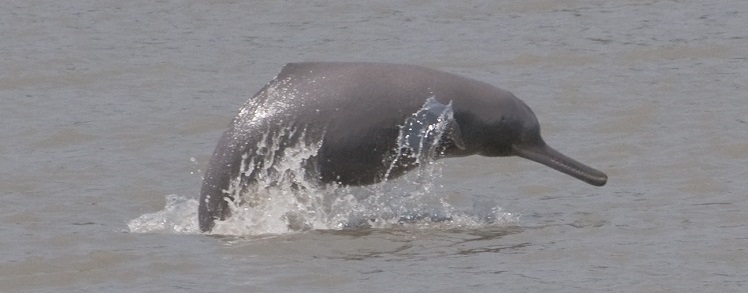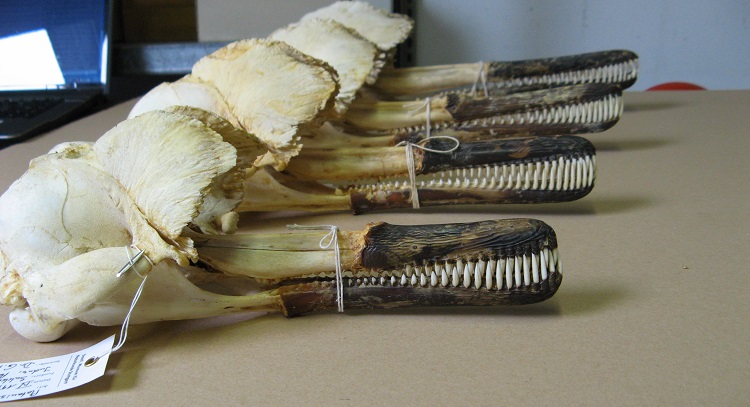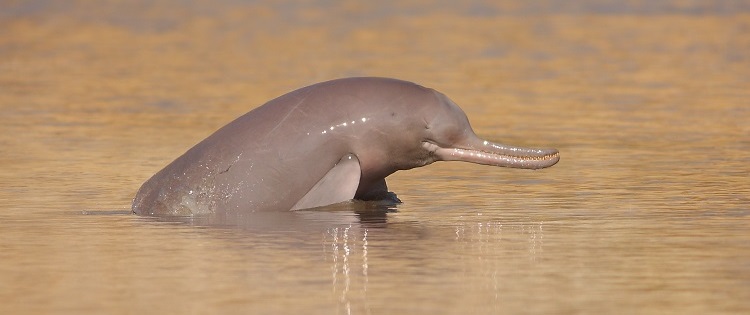
After two decades of research, a scientific study, led by the University of St Andrews, has recognised the endangered Indus and Ganges river dolphins as separate species.
Since the 1990s, river dolphins in South Asia were considered to be a single threatened species, however, a landmark study published today (Wednesday 24 March) in Marine Mammal Science concludes that the dolphins in the Indus River and those in the Ganges-Brahmaputra Rivers are sufficiently distinct to be classified as species in their own right.
The work, which took 20 years to complete, was led by Dr Gill Braulik of the Sea Mammal Research Unit (SMRU) at the University of St Andrews, who travelled across India and Pakistan searching for dolphin skulls to measure for the study.
The research shows that the two river dolphin species have different numbers of teeth, colouration, growth patterns and skull shapes as well as clear genetic differences.
Dr Braulik said: "Recognising the species-level differences between Indus and Ganges river dolphins is extremely important as only a few thousand individuals of each species remain.
"They have long been regarded as two of the world's most threatened mammals and my hope is that our findings will bring much-needed attention to these remarkable animals to help prevent them sliding towards extinction."

The research was a long-term collaboration between the University of St Andrews, WWF-Pakistan, Patna University in India, and the Southwest Fisheries Science Center of the National Oceanic and Atmospheric Administration in the US, as well as many other researchers in South Asia.
The Indus and Ganges river dolphins are often referred to as blind dolphins because they live in naturally muddy rivers and, over millions of years of evolution, have lost their eyesight and instead rely on a sophisticated sonar or echolocation system to navigate and catch prey.
Both species are listed as Endangered on the IUCN Red List and are threatened by accidental entanglement and drowning in fishing nets, pollution of their waterways and by the construction of hydropower dams and irrigation barrages.
Dr Randall Reeves, Chair of the IUCN Cetacean Specialist Group, said: "The rapid decline and extinction of the Yangtze River dolphin this century was a very clear warning: we need to act quickly to protect the remaining species of river dolphins, including the Indus and Ganges, all of which are seriously threatened. The freshwater systems they inhabit must be managed with biodiversity as a top priority."

The population of Ganges river dolphins is declining and estimated at several thousand individuals spread across the rivers of Bangladesh, India and Nepal.
Meanwhile, Indus river dolphins, which occur primarily in Pakistan, have achieved an impressive recovery over the last 20 years, with numbers going up from approximately 1,200 in 2001 to almost 2,000 in 2017, despite huge challenges, including an 80 per cent decline in the extent of their range.
Dr Uzma Khan, Asia Coordinator of the WWF River dolphin initiative, said: "The Indus river dolphin recovery in Pakistan is due to decades of dedicated on the ground work with the government authorities and communities and shows what is possible when we work together.
"Serious challenges still face this incredible species and all other river dolphin populations, but we can save them - and by doing so we'll save so much more since hundreds of millions of people and countless other species depend on the health of river dolphin rivers."
The final decision on the validity of the new species will be made by the Committee on Taxonomy of the Society for Marine Mammalogy in the next few months.
The paper, 'Taxonomic revision of the South Asian River Dolphin (Platanista): Indus and Ganges River dolphins are separate species' by Gill T Braulik, Frederick Archer, Uzma Khan, Mohammed Imran, Ravindra K. Sinha, Thomas A Jefferson, Carl Donovan and Jeff A Graves is published in Marine Mammal Science and available online.
Please ensure that the paper's DOI [10.1111/mms.12801] is included in all online stories and social media posts and that Marine Mammal Science is credited as the source.
Additional Notes
In the early 1970s, an Italian scientist named Giorgio Pilleri captured a small number of river dolphins from the Indus River in Pakistan and brought them back to Berne in Switzerland to study them. None of the dolphins survived in his aquarium for more than a few months. However, upon examining their skulls, Pilleri determined that they were a different species from river dolphins found in the neighbouring Ganges River in India.
Later, scientists dismissed Pilleri's claims and in the late 1990s the freshwater dolphins in the Indus and the Ganges were combined back into a single, highly endangered, species. Now, in a landmark study published in the journal Marine Mammal Science, experts have determined that Pilleri was correct, concluding that the dolphins in the Indus River and those in the Ganges-Brahmaputra Rivers are sufficiently distinct to be classified as species in their own right.
Recently, new species of whales and dolphins have been in the news. A new species of large whale was described in the Gulf of Mexico and a possible new deep diving beaked whale was seen off the coast of Mexico. These cases reveal not only how much we still have to learn about whales and dolphins, but, even for dolphin species in rivers that live amongst millions of humans, how difficult it is to gather enough information to able to understand and scientifically describe them. Recognition and naming of species is essential if they are to get the protection they need.
The following river dolphins remain worldwide:
- Irrawaddy dolphins in the Mekong River, Cambodia: Critically Endangered
- Irrawaddy dolphins in the Ayeyarwady River, Myanmar: Critically Endangered
- Irrawaddy dolphins in the Mahakam River, Indonesia: Critically Endangered
- Yangtze finless porpoise in the Yangtze River, China: Critically Endangered
- Amazon River dolphin in the Amazon and Orinoco Rivers in South America: Endangered
- Tucuxi in the Amazon basin in South America: Endangered
- Indus River dolphin, Indus River system, Pakistan and India: Endangered
- Ganges River dolphin, Ganges-Brahmaputra River system, India, Bangladesh and Nepal: Endangered






